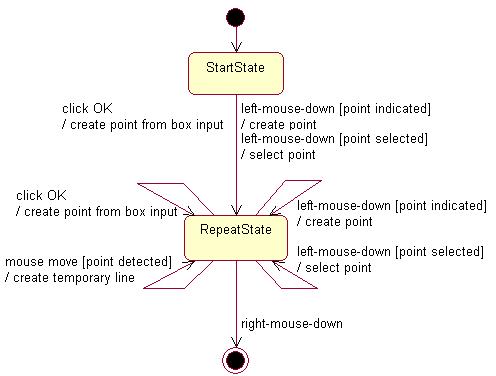
3D PLM Enterprise Architecture |
User Interface - Commands |
Associating a Dialog Box with a Dialog Agent - 1Using an existing notification to value a dialog agent |
| Use Case | ||
AbstractThis article shows how to use a dialog box to value a dialog agent. The agent is valuated by a notification sent by the Dialog box. In this article, the agent is valuated by an existing notification of the CATDlgDialog class: either the OK, Cancel, Close, and so one notification. For a valuation by a new notification refer to the second part of this article [0] |
This use case is intended to show how to use a dialog box associated with a dialog agent in a state dialog command. The dialog box values the dialog agent when the end user presses the OK push button. This dialog box is used to input precise values rather than using the mouse to indicate a point on the screen.
[Top]
The Polyline command is a use case of the CAADialogEngine.edu framework that illustrates the DialogEngine framework capabilities.
[Top]
The Polyline command creates a polyline by successively indicating or selecting points, or entering their coordinates using a dialog box. A right click stops the polyline creation and exits the command.
The Polyline command is a state dialog command according to the following UML statechart diagram [1].

The dialog is as follows:
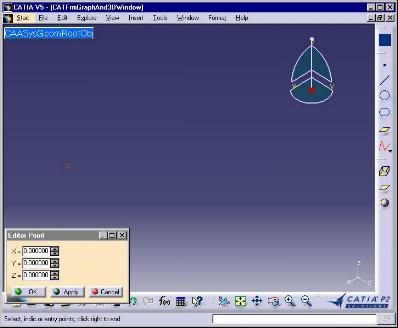 |
Select the Polyline command. The active state becomes StartState, and the dialog box is displayed. You can either indicate or select a point, or use the dialog box. |
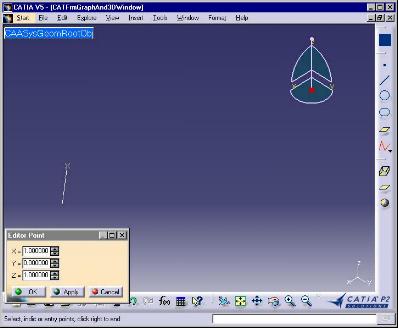 |
Click to indicate a point. The point is created. The transition makes the RepeatState the active state. The self transition that creates a temporary line is triggered as long as the mouse moves, even to locate it in the dialog box. |
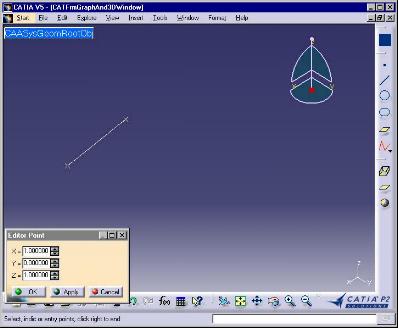 |
Enter values in the dialog box spinners. Clicking OK creates the point whose coordinates were entered and creates a line segment between the two points. You can again either click to indicate or select a point, or use the dialog box. |
 |
Enter another set of values in the dialog box spinners and click OK. A third point and a second line segment is created. |
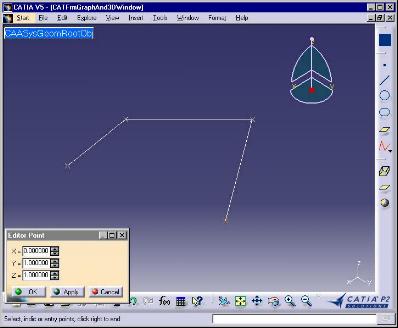 |
Enter another set of values in the dialog box spinners and click OK. A fourth point and a third line segment is created. Go on indicating or selecting points, or entering values in the dialog box and clicking OK to add line segments to the polyline, or right click to end the command |
Indicating a point [2] means clicking on the screen at the desired location with the left mouse key. Selecting a point [3] means clicking on an existing point. A third way to create points is to enter their absolute coordinates in a dialog box. The dialog box is associated with a dialog agent and pressing OK in the dialog box values the dialog agent. This triggers a transition that creates a point with the entered coordinates, and that creates a line segment using the last two created points. We focus on the RepeatState and its self transition that is triggered by the dialog box.
[Top]
See the section entitled "How to Launch the CAAGeometry Use Case" in the "The CAAGeometry Sample" use case for a detailed description of how this use case should be launched.
Then, in the window where you run the mkrun command, do not type the module name on the command line, but type CNEXT instead. When the application is ready, do the following:
[Top]
The Polyline command is made of a single class named CAADegCreatePolylineCmd located in the CAADegGeoCommands.m module of the CAADialogEngine.edu framework:
| Windows | InstallRootDirectory\CAADialogEngine.edu\CAADegGeoCommands.m\ |
| Unix | InstallRootDirectory/CAADialogEngine.edu/CAADegGeoCommands.m/ |
where InstallRootDirectory is the directory where the CAA CD-ROM
is installed.
[Top]
To create the CreatePoint, there are seven steps:
| # | Step | Where |
|---|---|---|
| 1 | Declare the dialog agent and the dialog box | Header file |
| 2 | Instantiate the dialog agent | BuildGraph method [4] |
| 3 | Instantiate the dialog box | BuildGraph method |
| 4 | Associate the dialog box with the dialog agent | BuildGraph method |
| 5 | Create the RepeatState and plug the dialog agent | BuildGraph method |
| 6 | Create the self transition | BuildGraph method |
| 7 | Release the indication agent and the dialog box | Destructor |
[Top]
The CAADegCreatePolylineCmd state command class derives from CATStateCommand.
...
class CAADegCreatePolylineCmd : public CATStateCommand
{
...
private :
...
CATDialogAgent * _daEditor; // Dialog agent to associate with the dialog box
CAADegPointEditor * _PointEditor; // Dialog box
...
|
The private part of its header file includes the dialog agent declaration, as well as other members. The dialog agent to associate with the dialog box is a CATDialogAgent instance. The dialog box is a CAADegPointEditor instance that contains a spinner for each coordinate, and the OK, Apply, and Cancel push buttons.
[Top]
The dialog agent is instantiated in the BuildGraph method.
void CAADegCreatePolylineCmd::BuildGraph()
{
...
_daEditor = new CATDialogAgent("PointEditorId");
_daEditor->SetBehavior(CATDlgEngRepeat);
...
|
The character string PointEditorId defined as the argument of
the CATDialogAgent constructor is the dialog agent identifier. This
identifier can be used to assign undo/redo prompts replacing the Undo and Redo
items in the Edit menu. The dialog agent behavior is set to CATDlgEngRepeat
to enable the dialog agent to be valued more than once without being
reinitialized and nevertheless remain usable to trigger a transition using the IsLastModifiedAgentCondition
method.
[Top]
This is done in the BuildGraph method.
...
CATApplicationFrame * pFrame = NULL ;
CATDialog * pParent = NULL ;
pFrame = CATApplicationFrame::GetFrame() ;
if ( NULL != pFrame ){
pParent = pFrame->GetMainWindow() ;
}
_PointEditor = new CAADegPointEditor(pParent);
_PointEditor->Build();
...
|
The dialog box is instantiated and built. It is an instance of the CAADegPointEditor
class that derives from the CATDlgDialog class and that simply includes a
spinner for each coordinate, and three push buttons OK, Apply, and Cancel.
Dialog boxes should always be instantiated without controls (or other dialog
objects). Instantiating these controls in a Build method called
after the constructor has returned make sure that the control resources will be
correctly allocated.
The parent of this dialog box is an invisible dialog object which contains
all the windows of the same document. This object is returned by the GetMainWindow
method on the application frame. Refer to the article entitled
"Understanding the Application Frame Layout" [6]
for complete details about this object.
[Top]
This association is declared in the BuildGraph method.
... _daEditor->AcceptOnNotify(_PointEditor, _PointEditor->GetDiaOKNotification()); ... |
The AcceptOnNotify method enables the dialog agent to be valued
whenever the dialog box sends an OK notification. This is an instance of the CATDlgDiaOKNotification
class retrieved thanks to the GetDiaOKNotification method.
[Top]
This is still done in the BuildGraph method.
...
CATDialogState *stRepeatState = AddDialogState("stRepeatPointId");
...
stRepeatState->AddDialogAgent(_daEditor);
...
|
The RepeatState is not the first state in the command statechart diagram and
is therefore created using the AddState method. The AddDialogAgent
method plugs the dialog agent to the state.
[Top]
The last to do is to create the self transition triggered when the dialog agent is valued by the OK notification, and that creates the point with the entered coordinates and the corresponding line segment.
...
CATDialogTransition *pRepeatTransitionBox = AddTransition
(
stRepeatState,
stRepeatState,
AndCondition(IsLastModifiedAgentCondition(_daEditor),
Condition((ConditionMethod) & CAADegCreatePolylineCmd::CheckPointByBox)),
Action(
(ActionMethod) & CAADegCreatePolylineCmd::CreateLineByBox,
(ActionMethod) & CAADegCreatePolylineCmd::UndoCreateLine,
(ActionMethod) & CAADegCreatePolylineCmd::RedoCreateLine
)
);
|
The AddTransition method creates a transition and adds it to the
transitions managed by the dialog command. Pointers to the transition's source
and target states are the first and second arguments respectively. This self
transition goes from/to the same RepeatState. The transition trigger is defined
in the guard condition as the first condition to be checked using the IsLastModifiedAgentCondition
method applied to the indication agent. This method returns True when the dialog
agent is valued or if its value is modified. Modifying the value of the dialog
agent is made possible because the dialog agent behavior is set to
CATDlgEngRepeat. Using IsLastModifiedAgentCondition doesn't require
to reinitialize the dialog agent. A second condition uses the CheckPointByBox
method. Because we use AndCondition to create the guard condition,
both condition methods must return True to fire the transition. In this case,
the CreateLineByBox action method is executed. The two other action
methods are dedicated to respectively undo and redo the action.
[Top]
A pointer to the dialog agent was created in the command BuildGraph
method as a data member to be accessed and used in different methods. It
should be released (RequestDelayedDestruction) when it becomes
useless. This can be done in the command destructor, as shown here. This could
also be done in the Cancel method called just before the
destructor. In the same way, the dialog box should be destructed by using the RequestDelayedDestruction
method.
CAADegCreatePolylineCmd::~CAADegCreatePointCmd()
{
if (_daEditor) _daEditor->RequestDelayedDestruction() ;
_daEditor = NULL ;
if (_PointEditor) _PointEditor->RequestDelayedDestruction();
_PointEditor = NULL ;
...
|
[Top]
This use case shows how to valuate a dialog agent by a notification sent by a Dialog box.
[Top]
| Version: 1 [Jan 2000] | Document created |
| [Top] | |
Copyright © 2000, Dassault Systèmes. All rights reserved.